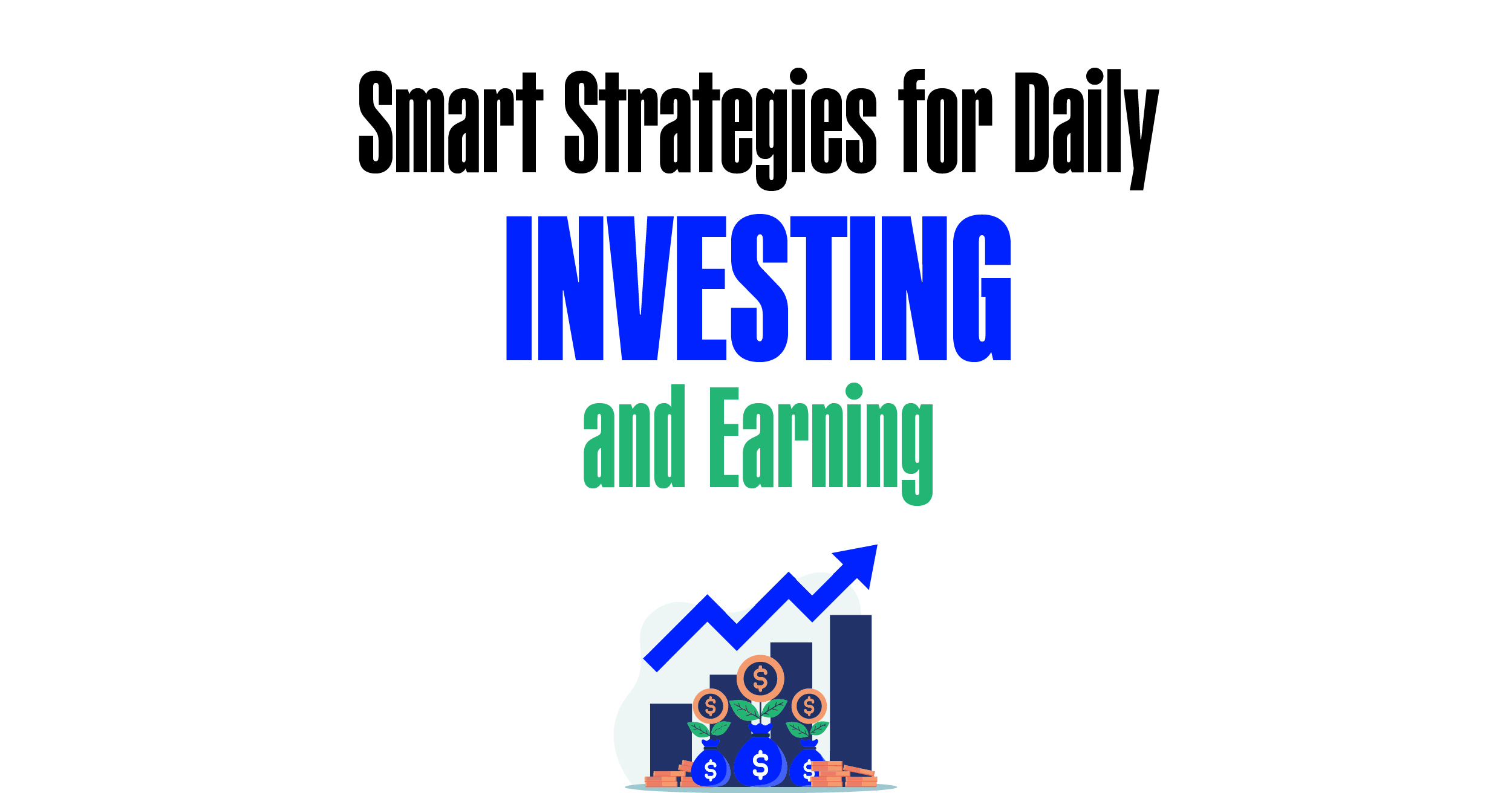To invest and make money daily, explore day trading or dividend stocks. Consider high-yield savings accounts for steady growth.
Navigating the world of investments offers a promising avenue for those aiming to grow their wealth. The key to success lies in understanding the various strategies available, such as day trading, which involves buying and selling stocks within the same trading day, or investing in dividend-paying stocks for regular income.
High-yield savings accounts also provide an opportunity for steady, albeit slower, financial growth. This introduction serves as a gateway for beginners and seasoned investors alike, seeking to make informed decisions that align with their financial goals and risk tolerance. By focusing on these approaches, individuals can potentially see daily returns on their investments, contributing to their overall financial stability and growth.
Introduction To Daily Investing
Introduction to Daily Investing opens a world of opportunities. It promises the chance to make money every day. This approach requires understanding and strategy. Let’s dive into what makes daily investing attractive and what to consider.
The Allure Of Daily Returns
Daily investing means earning money each day. This idea excites many. Why? Because it offers quick gains. Unlike long-term investments, daily investing shows results fast. This fast pace appeals to those seeking rapid growth.
- Immediate results: You see your money grow daily.
- Flexibility: Invest based on daily market trends.
- Compounding: Reinvest earnings for more growth.
Key Considerations Before Starting
Before jumping into daily investing, think carefully. It’s not all easy. Knowledge, risk tolerance, and time are crucial. Here’s what you need to know:
- Understand the market: Know how markets work.
- Risk management: Be ready for ups and downs.
- Time investment: Daily investing needs your time.
Start with a plan. Choose strategies that fit your goals. Remember, patience and learning are key.
Setting Investment Goals
Smart investors know that setting clear goals is key to success. Before you start, define what you hope to achieve. This will guide your strategy and help you stay on track.
Short-term Vs Long-term
Your investment timeline impacts your strategy. Short-term goals often mean less time for growth. Long-term goals can ride out market ups and downs.
- Short-term: Save for a car or vacation
- Long-term: Plan for retirement or your child’s education
Risk Tolerance Assessment
Different investments carry different risks. Know your comfort level with potential losses. This shapes your investment choices.
| Risk Level | Investment Type |
|---|---|
| Low | Savings accounts, CDs |
| Medium | Mutual funds, Index funds |
| High | Stocks, Cryptocurrencies |
Understanding The Markets
When diving into the world of investing, understanding markets is key. Markets can be complex. Yet, they offer daily money-making opportunities. Grasping the basics leads to better investment choices. Let’s explore how to navigate these financial landscapes.
Stock Market Basics
The stock market is a hub for buying and selling shares. Shares represent ownership in companies. Prices fluctuate based on supply and demand. Investors aim to buy low and sell high. Knowledge is power in this arena.
- Indexes: These track market segments. Examples include the S&P 500 and Dow Jones.
- Stocks: They are equity investments. They offer a slice of company ownership.
- Dividends: Some stocks pay these. They are profit shares to stockholders.
Alternative Markets For Daily Investments
Beyond stocks, other markets allow daily investments. These include cryptocurrencies, commodities, and Forex. Each market has unique characteristics.
| Market Type | Characteristics | Investment Style |
|---|---|---|
| Cryptocurrencies | Digital, volatile, 24/7 trading | Short-term, speculative |
| Commodities | Physical goods like gold, oil | Long-term, diversification |
| Forex | Currency trading, high liquidity | Short-term, leverage |
Each market requires specific strategies. Investors must study trends and news. Risk management is crucial. Diversification can reduce risk. Starting with small investments is wise. It helps in learning the market dynamics.
Smart Investment Strategies
Smart Investment Strategies can help you grow your money daily. It’s important to understand the options. You need to pick strategies that match your goals. A smart approach involves research and continuous learning. Let’s explore some effective strategies.
Diversification
Diversification reduces risk in your investment portfolio. It involves spreading your investments across various assets. You can invest in stocks, bonds, and real estate. Diversification helps protect your money. It minimizes losses if one investment performs poorly.
- Stocks: Buy shares in different companies and sectors.
- Bonds: Loan money to corporations or governments.
- Real Estate: Invest in property for rental income or value appreciation.
High-frequency Trading (hft)
High-frequency trading uses powerful computers to execute many trades in seconds. It aims to capture small price differences. HFT can be profitable. Yet, it involves significant risk and requires advanced knowledge.
| Aspect | Detail |
|---|---|
| Speed | Trades executed in milliseconds |
| Technology | Advanced algorithms and high-speed networks |
| Risk | High, due to the fast pace and volatility |
Tools Of The Trade

Smart investors know that the right tools can make all the difference. Whether you’re a seasoned pro or just starting out, these tools can help you make informed decisions and potentially increase your daily earnings. Let’s dive into the essential software and apps, plus the analytical resources you need.
Essential Software And Apps
Investing requires robust software and user-friendly apps. They keep you connected to the markets.
- Brokerage platforms: Execute trades quickly.
- Mobile trading apps: Monitor investments on-the-go.
- Portfolio management tools: Track performance easily.
- Budgeting apps: Manage your finances effectively.
Analytical Resources
Success in investing often hinges on quality research and analysis. Use these resources to stay ahead.
- Real-time data feeds: Get market updates instantly.
- Charting software: Visualize market trends.
- Investment news apps: Access the latest news fast.
- Economic calendars: Keep track of important events.

Credit: www.linkedin.com
Risk Management
Investing with a strategy to make money daily involves risks. Smart investors manage these risks. They use tools and techniques to protect their investments. This section will explain two key risk management strategies.
Stop-loss Orders
A stop-loss order is an investor’s safety net. It limits potential losses. When a stock price falls to a certain level, the stop-loss order triggers. This automatically sells the stock. It prevents further losses.
Benefits of stop-loss orders:
- Set it and forget it: Once set, the order works automatically.
- Emotion-free: It removes the decision-making during a market drop.
- Discipline: Investors stick to their exit strategy.
Position Sizing
Position sizing is crucial for daily investors. It means deciding how much to invest in a single trade. This ensures no single loss can ruin the entire portfolio.
Key points of position sizing:
- Calculates the risk before investing.
- Keeps the risk consistent across trades.
- Helps avoid overexposure to one investment.
| Account Size | Risk per Trade | Position Size |
|---|---|---|
| $10,000 | 1% | $100 |
| $10,000 | 2% | $200 |
By using stop-loss orders and position sizing, investors protect their portfolios. They can invest and aim to make money daily with less worry. These strategies are key to managing investment risks.
Learning From The Experts
Learning from the Experts is a key step in investing. It helps you make money every day. You can learn from those who have done it before. They know the best tricks and tips.
Mentorship And Courses
Finding a mentor can change your investing game. A good mentor has years of experience. They can guide you through tough times. They show you how to avoid common mistakes. This helps you make better decisions.
Many online courses exist. They teach you how to invest. Look for courses with high ratings. They should also have real-life examples. This makes learning easier and more fun.
- Benefits of Mentorship:
- Personalized advice
- Insider knowledge
- Support when you need it
- Choosing the Right Course:
- Check reviews
- Look for success stories
- Ensure it covers daily investing
Case Studies Of Successful Daily Investors
Learning from success stories is powerful. It shows what works. It also shows what doesn’t. Here are a few examples of people who make money daily.
| Name | Strategy | Daily Earnings |
|---|---|---|
| John Doe | Stock Trading | $500 |
| Jane Smith | Cryptocurrency | $300 |
| Mike Brown | Forex Trading | $450 |
These case studies show different strategies. They prove that daily earnings are possible. Learn from their journeys. Try to apply their strategies to your investing.
Common Pitfalls To Avoid
Investing your money can lead to daily profits. Yet, it’s easy to fall into traps. Here, we’ll explore common mistakes to dodge.
Emotional Trading Decisions
Keep emotions in check while investing. Don’t let fear or excitement guide your choices. A clear strategy is key. Emotional decisions can lead to rash moves. These moves might hurt your investment goals.
Overleveraging
Using leverage means borrowing money to invest. It can amplify gains. But, it also increases losses. Don’t borrow more than you can afford to lose. This is overleveraging. It’s a quick way to deplete your funds. Stick to investments within your means.
Building A Sustainable Routine
When it comes to investing, understanding the legal and tax implications is crucial. It ensures you stay compliant while maximizing returns. Let’s dive into what you need to know about trader status and tax-efficient strategies.
Understanding Trader Status
Trader status affects how the IRS views your activities. It’s not just about frequent trading. The IRS considers your intent, the nature of your gains, and your trading behaviors.
- Full-time traders face different tax rules than occasional investors.
- Claiming trader status allows the deduction of certain expenses.
- Qualification criteria include trading frequency and the pursuit of profit.
Trader status can lead to significant tax benefits. Make sure you qualify before claiming it on your taxes.
Tax-efficient Investment Strategies
Tax efficiency can boost your investment returns. Use strategies that minimize your tax liability. Here are some to consider:
- Retirement accounts like IRAs or 401(k)s offer tax benefits.
- Index funds have lower turnover rates, resulting in fewer taxable events.
- Consider tax-loss harvesting to offset capital gains.
Invest in tax-friendly assets and accounts. Always consult with a tax professional to optimize your strategy.

Credit: www.webmonkey.com
Legal And Tax Implications
Evaluating performance is key to investing success. It involves regularly checking your investments against certain standards. This helps to know if you’re on track. Let’s dive into how to do this effectively.
Benchmarking Against Indices
Investors often compare their returns to market indices. These indices reflect the market’s overall performance. They serve as a yardstick for your investment’s success. Popular indices include the S&P 500 and NASDAQ.
- Find an index that matches your investment type.
- Use it to gauge your investment’s performance.
- Ensure the index aligns with your investment goals.
Adjusting Strategies Over Time
Markets change and so should your strategies. It’s important to adapt your approach to stay ahead. Regular reviews can highlight what’s working and what’s not.
- Review your investment strategy every quarter.
- Look for trends in the market.
- Make changes to optimize returns.
Adaptation and flexibility are crucial. They can make the difference in how much you earn daily.

Credit: barbarafriedbergpersonalfinance.com
Frequently Asked Questions
What Is The Best Investment For Daily Income?
Dividend stocks and peer-to-peer lending are top choices for daily income. Both options offer regular, passive returns, ideal for investors seeking consistent earnings. Carefully select high-yield stocks and reputable lending platforms to maximize your daily income potential.
How To Earn $500 Per Day With Investment?
To earn $500 per day with investment, start by diversifying your portfolio across stocks, real estate, and cryptocurrencies. Focus on high-return options, actively trade, and consider leveraging affiliate marketing. Constantly educate yourself on market trends and seek advice from financial experts.
How Much Invested To Make $1,000 A Day?
To make $1,000 a day through investment, the amount needed varies. It depends on the expected return rate; for a 10% return, you’d need to invest $3,650,000.
How Much Money Do I Need To Invest To Make $3,000 A Month?
The investment needed to generate $3,000 a month varies by investment type and its return rate. For example, at a 5% annual return, you would need to invest approximately $720,000.
Conclusion
Embarking on daily investment ventures can boost your financial growth significantly. Start small, diversify your portfolio, and stay informed to navigate the market confidently. Remember, patience and persistence are your allies in the journey to daily earnings. Take that first step towards making your money work for you, every single day.

